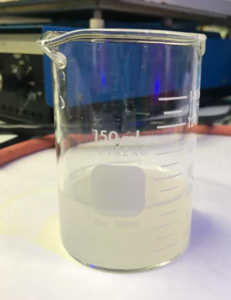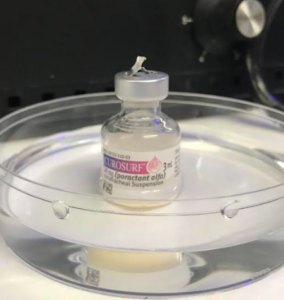Week 8: Modifications + Moving Forward!
April 28, 2024
Hi everyone and welcome back to my senior project blog! It’s hard to believe that 8 weeks have gone by already!
This week I focused mainly on two tasks. First was updating my methodology based on the observations I collected from my initial trial of Silk Fibroin (SF) microspheres. Second was including the CUROSURF lung surfactant loading process into my methodology.
Reflecting on the data I collected from my initial batch of microspheres, my goals for my new methodology were for it to create microspheres that were more uniform in size and more evenly distributed throughout the solution. I first decided to create the initial PVA and SF solutions over hot plates to allow for greater uniformity in the solution and to ensure that all particles were dissolved. I also decided to adjust the time and amplitude that was used for sonication of the final SF microsphere solution. This is because, in the methodology, sonication was used to disperse microspheres in the solution so in order to help separate the microparticles, I increased the time and amplitude of the sonication 30 seconds at 30% amplitude to help decrease clustering and agglomeration of the microspheres. In the next few weeks I will be able to see how these changes will affect the qualities and characteristics of the new SF microspheres.
After I made those adjustments to my protocol, I also added in the steps to load the microspheres with CUROSURF. As I explained in earlier weeks, this CUROSURF surfactant needs to be delivered into the lungs of babies affected with Neonatal Respiratory Disease Syndrome (NRDS). Here are the basic steps I followed:
- To load the natural lung surfactant CUROSURF into our silk fibroin microspheres, stock solutions of CUROSURF were prepared with a concentration of 5 mg/mL in the PBS buffer (with a pH of 7.4) and stored at -20°C. The PBS buffer helped maintain a constant pH and also prevented cells from rupturing or shriveling up due to osmosis.
- Before preparing the silk microspheres, certain amounts of CUROSURF stock solution were added to the silk solutions using a micropipette to reach a weight ratio of 1:100 between the drug (CUROSURF) stock solution and aqueous SF. After mixing, the SF and CUROSURF solution was used to blend with the PVA solution following the steps described in the silk sphere preparation in order to actually load the SF microspheres with the surfactant.


That’s all for this week! Stay tuned for next week where I will observe these new microspheres!

Leave a Reply
You must be logged in to post a comment.